| The New Chapel
Land for the new chapel was purchased for £52.10s. and
building work quickly commenced. Like the old meeting
house, it was a square brick building without any
decoration. The inside was plain with a pulpit fixed
against the back wall and complete with a sounding board
above and a clerk's desk below. The chapel was
surrounded by a graveyard, where many members of the
congregation would be buried in the fullness of time.
The chapel opened for worship in 1782, the first 18
members being from the old St. John's Lane meeting
house. They were as follows:
Lydia Butler, John Evans, John Hasbury, James Higgins,
Charles Hunter, Elizabeth Hunter, John Johnson, Jane
Kenrick, Esther Mander, John Mander, Elizabeth Orme,
Esther Parrock, Mary Rooker, John Smith, William Stone,
Sarah Stonely, Mary Thompson, and Thomas Thompson. |

The location of
Temple Street Chapel. From the 1842 tithe
map. |
The minister and his wife were James and Mary
Wraith. James was born in May, 1734 at Elland in
Yorkshire. He became the village preacher and continued
as such for 15 years until he received an invitation to
preach at Bolton Congregational Church, where he
remained until the commencement of his appointment at
Grey Pea Walk on 7th June, 1782.
In 1788 the chapel was put in trust and a number of
trustees were appointed. Mr. Wraith appears to have been
popular with the local Christian community and parents
travelled from all around to have their children
baptised by him. They came from as far afield as
Bilston, Brewood, Brierley Hill, Bushbury, Sedgley,
Shareshill, and West Bromwich. |
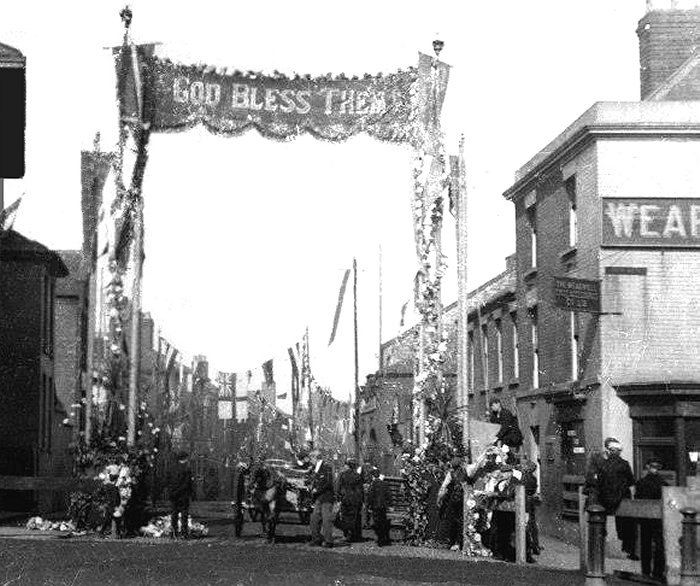
Part of a poor quality copy of
a photograph showing the view into Temple Street
from Snow Hill. The chapel can be seen a little way
down on the right. The banner was for the visit of
the Duke of York in 1900. |
| He stayed in Wolverhampton for 10 years before
moving to Hampstead, where he died in 1815. Mr. Wraith's
replacement was John Godwin, a strong, warm-hearted
Calvinist. He quickly appointed two new deacons,
Benjamin Mander and William Foster, to increase the
number of deacons to 4. The existing two were John
Mander and John Smith. The French Revolution in 1791
caused great excitement in the country and the "Church
and King" riots occurred in Birmingham. Many of the
meeting houses were pulled down, and the library and
scientific works of Joseph Priestly were burnt by the
mob. The people still worshipping in St. John's Lane
held the same religious opinions as Dr. Priestly and
were subjected to similar treatment. Although the chapel
in Temple Street escaped this fate the congregation were
subjected to much abuse and persecution. The windows at
the front of the chapel were protected by shutters and
young gentlemen would frequently knock the shutters with
a stick to disturb the preacher during a service. |
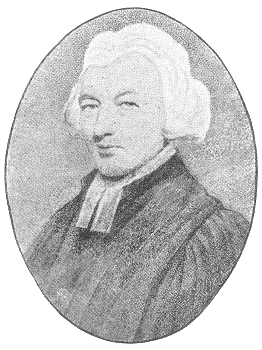
James Wraith. From
“Congregational
Churches of Wolverhampton, 1662-1894” by W.H. Jones. |
After the end of the Napoleonic Wars in 1815, the
country went into a depression. It was a wet summer and
crops failed making food prices extortionately high.
Taxes were also at a record high due to the war and so
was unemployment. The congregation at Temple Street were
so poor at the time that they were unable to find the
pastor's salary of £40. On hearing the sad news, John
Godwin replied "Give me a crust and I will never leave
you; I will share a crust with you" and he remained as
preacher at the chapel until his death in 1829.
It would seem that worshippers slowly tired of Mr.
Godwin's services and numbers dwindled. The possible
cause could have been his failure to administer the
sacrament, aided by the fact that he did not consider
the congregation to be Christians. For whatever reason
the congregation continued to reduce in number and even
some of the original founders moved elsewhere. |
|
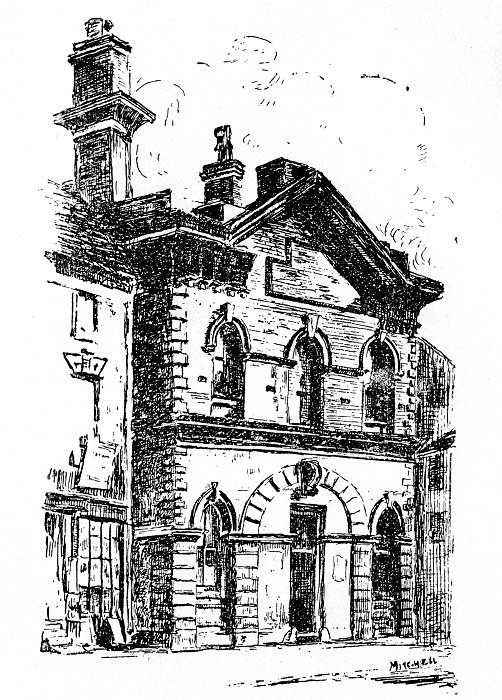
The Princess Street Chapel by
A. Bradney Mitchell. |
John and Benjamin Mander sometimes attended services
at Pountney's Fold and considered themselves as
occasional members of that chapel, and full members at
Grey Pea Walk. They also became disillusioned with Mr.
Godwin and John purchased a piece of land in Princess
Street on which to build a larger chapel for the
Pountney's Fold congregation.
The new chapel opened in 1809 and John and Benjamin
Mander eventually left the Temple Street chapel to
become full members of the Princess Street congregation.
It appears that the new chapel was a great success and
the congregation grew too large for the building. John
purchased a piece of land on the corner of Market Street
and Queen Street on which to build a new congregational
church. The Princess Street premises were sold back to
him for £400 to help finance the venture and the Queen
Street Congregational Church opened in September, 1813.
|
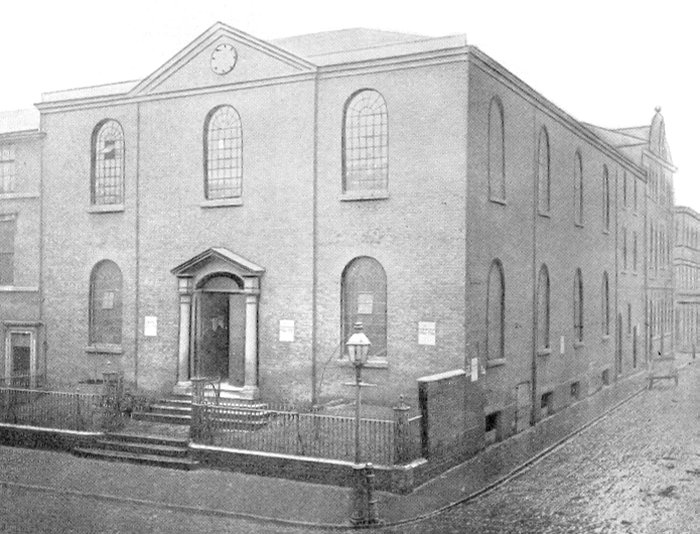
The Queen
Street Congregational Church. From “Queen Street
Congregational Church Wolverhampton” by Henry A. May. |
In order to help with finances, John rented out the
vaults in the new church, and much to the dismay of some
of the congregation he let them to a wine and brandy
merchant.
The story goes that one morning the following was found
written on the door:
"There are spirits above and spirits below;
There are spirits of joy and spirits of woe.
The spirits above are spirits divine;
The spirits below are spirits of wine." |
The Final Years at
Temple Street
During the last few years of Mr. Godwin's life the
number of people in the congregation fell to an all-time
low and after his death in 1829 the chapel remained
without a pastor until the appointment of Mr. Henry
Rogers in 1832. He introduced a form of prayer similar
to that used by the "Lady Huntingdon's Connexion", but
the congregation preferred the simple form of worship
with which they were familiar.
During his time at Temple Street the old fashioned
windows and shutters at the front of the chapel were
replaced and the front of the building improved.
Unfortunately the number of worshippers continued to
fall and when Mr. Rogers left Wolverhampton in 1843 they
consisted of just 11 people, and the chapel remained
without a pastor until 1846.
Meanwhile things were going wrong at Queen Street
Church. 48 members of the church and two deacons walked
out in August, 1845 following a difference of opinion
over the settlement of a minister. They formed
themselves into a new church, meeting at the Music Hall
in Cleveland Street.
After about three months they were approached by the
members of the Temple Street Chapel to ask if they could
join forces and a united fellowship was formed. During a
service at Temple Street on 6th November, 1845 both
groups entered into a covenant promising that in the
future they would be one church and one people. After
the union was established the original trust deed of the
Temple Street chapel was examined. Only one trustee, Mr.
Charles Mander remained and so new trustees were
appointed as follows:
Thomas Adams, cabinet maker; John Barker, ironmaster;
William Corns, coffee mill maker; Edward Cook,
gentleman; Sidney Cartwright, toy maker; Henry
Fearncombe, japanner; Edward Jones, japanner; Charles
Mander, varnish maker; J. Newey, pork butcher; Rob.
Smith, draper; S. Walters, carrier; and Martin Wilkes,
confectioner.
In 1846 the Rev. W.H. Heuderbourck became pastor. He was
an energetic, hard working and industrious man who
greatly inspired the worshippers. Every Sunday he opened
the Sunday school at 9 o'clock and afterwards conducted
the morning service. At 2 o'clock he gave the Sunday
school teachers a model lesson for the following Sunday
, conducted the evening service, followed by a short
prayer meeting.
He urged the church members to erect a new noble chapel,
saying that "We need a chapel that shall far outshine
the old-fashioned barn-like places our fathers built; a
proper Gothic stone building; a church." They took him
at his word and soon the project got underway.
|
| A new life for the chapel
The chapel soon became Wolverhampton's Temperance Hall,
where meetings and lectures to do with the temperance
movement were held.
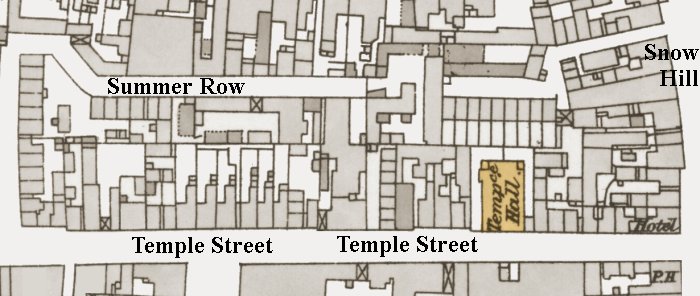
This map is based on the 1889
Ordnance Survey map, surveyed in 1885. |
|
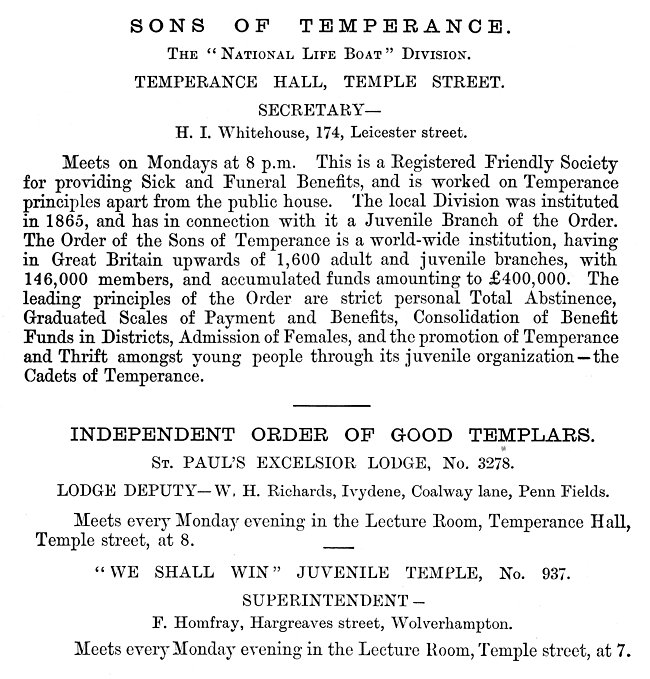
From the 1908 Wolverhampton Red
Book. |
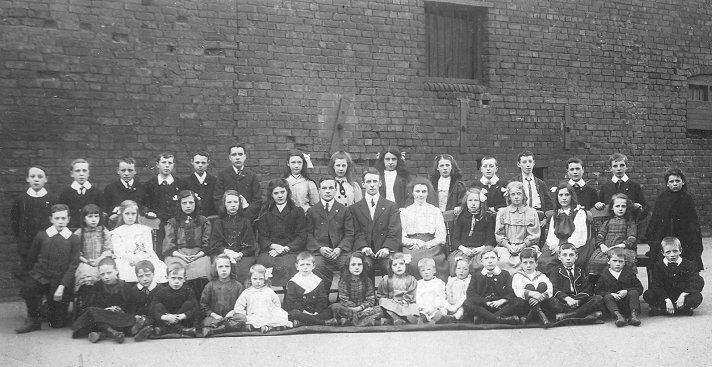
This lovely photo of the
Cadets of
Temperance, Temple Street, Wolverhampton, taken by
Cadwalender of Chapel Ash, was kindly sent-in by Susan
Anthony. As you can see, some of the recruits were very
young. |
| The Temperance Hall became available for all kinds
of public meetings, concerts and recitals, as can be
seen from the following two entries that are in the
Wolverhampton Red Books:

In 1913 the hall seated 250
people.

In 1930 the hall could accommodate
400 people. |

From the Express & Star, Saturday 4th April,
1931.
| The hall remained until the 1960s when it was
demolished to make way for the new, enlarged, Thomas
Clarkson and Sons Limited store with service access and
a car park at the rear. |
 |
|
 |
|
 |
Return to St. John's
Lane Meeting House |
|
Return to the
beginning |
|
Proceed to Snow Hill
Congregational Church |
|